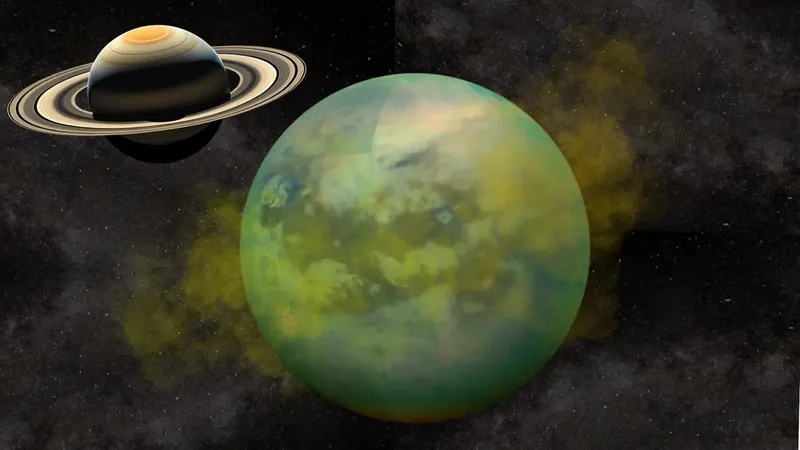
Is There Life on Titan? New Discoveries Suggest a Hidden Ocean Beneath a Methane Ice Crust!
2024-11-03
Author: Liam
Introduction
Scientists are buzzing with excitement after new findings indicate that Titan, Saturn's largest moon, could possess a remarkable layer of methane ice extending up to six miles (9.7 kilometers) thick beneath its icy surface. This discovery opens up tantalizing possibilities for the existence of life in the moon’s subsurface oceans, as the insulating properties of this methane crust may facilitate the detection of potential signs of life.
Why Titan is Fascinating
What makes Titan particularly fascinating—and similar to Earth—is that it is the only other celestial body known to host a dense atmosphere, along with rivers, lakes, and seas, albeit filled with liquid hydrocarbons such as methane and ethane instead of water. Despite the frigid temperatures on the moon, its surface ice is predominantly made of water, setting the stage for intriguing astrobiological prospects.
Research Insights
Recent research conducted by a team of planetary scientists at the University of Hawaii at Mānoa reveals that this methane-rich layer might also be trapping gas that could warm the overlying ice shell. This warming effect may assist in transporting important organic molecules to Titan's surface, potentially showcasing markers of life. Lauren Schurmeier, the lead of the research team, explained, "If organisms exist in Titan's ocean beneath the thick ice, any biological clues would need to be moved up to where we can analyze them. A warm ice shell would make this more feasible.”
Impact Crater Investigations
The team’s investigations into the peculiar shallow impact craters on Titan led to significant revelations. With only 90 visible craters, their shallowness perplexed scientists, as similar moons are expected to host numerous, deeper impacts due to their history of collisions. By employing advanced computer modeling techniques, the researchers hypothesized that the presence of a layer of insulating methane clathrate could be causing these shallow formations.
Methane Clathrate
Methane clathrate, often referred to as "methane hydrate," is a solid compound formed when methane gas is trapped within the crystalline structure of ice, giving it unique insulating properties. By comparing the characteristics of impact craters on Titan to those on Ganymede, an icy moon of Jupiter, the research team determined the thickness of the methane ice crust could range from five to ten kilometers. “Our simulations showed that a methane clathrate crust could provide a rapid relaxation process of the topography, causing the craters to evolve in a manner similar to fast-moving glaciers on Earth,” Schurmeier elaborated.
Significance of Findings
Understanding the dynamics of Titan’s methane clathrate crust is vital, as it may elucidate the processes driving the moon's distinctive methane-rich atmosphere and its carbon cycle. Titan acts as a natural laboratory, offering a glimpse into how greenhouse gases like methane cycle through extraterrestrial environments. Significantly, the lessons learned on Titan about methane clathrates could provide vital insights into Earth’s challenges with climate change, especially as these freezes are destabilizing in our polar regions.
Implications for Life
The implications of a warm interior, bolstered by a thick methane crust, suggest that Titan may not be the cold, rigid body once assumed. Instead, its environment might be more dynamic and conducive to harboring signs of life. "A clathrate crust is more resilient and insulating than regular water ice, which may facilitate the slow convection necessary to mobilize biological indicators from Titan's subsurface ocean to where we can investigate them," Schurmeier noted.
Future Exploration
As NASA gears up to explore these enthralling possibilities with the forthcoming Dragonfly mission, slated for launch in 2028 and arrival in the Saturnian system by 2034, the findings from this groundbreaking research could guide future exploratory efforts. The world watches closely to see if Titan will reveal its secrets and perhaps confirm the presence of life in the cosmos! This exciting research paper was published on September 30 in The Planetary Science Journal.









 Brasil (PT)
Brasil (PT)
 Canada (EN)
Canada (EN)
 Chile (ES)
Chile (ES)
 Česko (CS)
Česko (CS)
 대한민국 (KO)
대한민국 (KO)
 España (ES)
España (ES)
 France (FR)
France (FR)
 Hong Kong (EN)
Hong Kong (EN)
 Italia (IT)
Italia (IT)
 日本 (JA)
日本 (JA)
 Magyarország (HU)
Magyarország (HU)
 Norge (NO)
Norge (NO)
 Polska (PL)
Polska (PL)
 Schweiz (DE)
Schweiz (DE)
 Singapore (EN)
Singapore (EN)
 Sverige (SV)
Sverige (SV)
 Suomi (FI)
Suomi (FI)
 Türkiye (TR)
Türkiye (TR)
 الإمارات العربية المتحدة (AR)
الإمارات العربية المتحدة (AR)